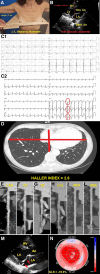Exercise-induced pseudo-ischaemic electrocardiographic changes in a female with concave-shaped chest wall
- PMID: 38515510
- PMCID: PMC10957157
- DOI: 10.1093/ehjcr/ytae123
Exercise-induced pseudo-ischaemic electrocardiographic changes in a female with concave-shaped chest wall
Conflict of interest statement
Conflict of interest: None declared.
Figures

Similar articles
-
False-positive electrocardiographic changes during exercise test in a patient with pectus excavatum.J Clin Ultrasound. 2020 Nov;48(9):579-584. doi: 10.1002/jcu.22831. Epub 2020 Apr 6. J Clin Ultrasound. 2020. PMID: 32249937
-
Both Bilateral Breast Volume Discrepancy and Asymmetric Anterior Chest Wall Shape Contribute to the Unsightly Breast Contour in Female Right Thoracic Idiopathic Scoliosis.Clin Spine Surg. 2017 May;30(4):E344-E350. doi: 10.1097/BSD.0000000000000128. Clin Spine Surg. 2017. PMID: 28437336
-
Prognostic Value of Modified Haller Index in Patients with Suspected Coronary Artery Disease Referred for Exercise Stress Echocardiography.J Cardiovasc Echogr. 2021 Apr-Jun;31(2):85-95. doi: 10.4103/jcecho.jcecho_141_20. Epub 2021 Jul 28. J Cardiovasc Echogr. 2021. PMID: 34485034 Free PMC article.
-
Exercise echocardiography.Aust N Z J Med. 1992 Oct;22(5 Suppl):610-2. doi: 10.1111/j.1445-5994.1992.tb00487.x. Aust N Z J Med. 1992. PMID: 1449449 Review.
-
Radiation therapy for breast cancer: Literature review.Med Dosim. 2016 Autumn;41(3):253-7. doi: 10.1016/j.meddos.2016.06.005. Med Dosim. 2016. PMID: 27545009 Review.
References
-
- Sonaglioni A, Baravelli M, Vincenti A, Trevisan R, Zompatori M, Nicolosi GL, et al. . A new modified anthropometric Haller index obtained without radiological exposure. Int J Cardiovasc Imaging 2018;34:1505–1509. - PubMed
-
- Udoshi MB, Shah A, Fisher VJ, Dolgin M. Incidence of mitral valve prolapse in subjects with thoracic skeletal abnormalities—a prospective study. Am Heart J 1979;97:303–311. - PubMed
-
- Boudoulas KD, Pitsis AA, Mazzaferri EL, Gumina RJ, Triposkiadis F, Boudoulas H. Floppy mitral valve/mitral valve prolapse: a complex entity with multiple genotypes and phenotypes. Prog Cardiovasc Dis 2020;63:308–326. - PubMed
Publication types
LinkOut - more resources
Full Text Sources
